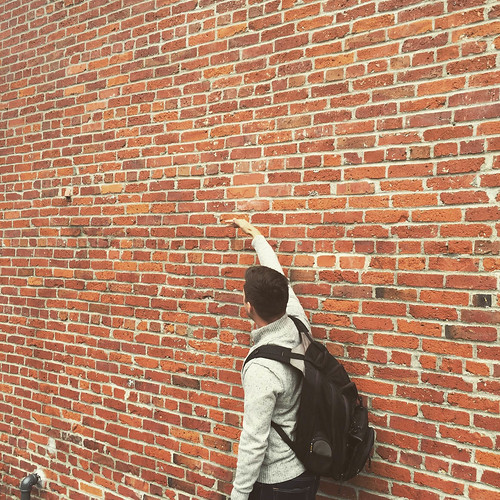At Large in Ballard: Corner of past and future
Top of Ballard Avenue with Caelen Bell.
Wed, 09/30/2015
By Peggy Sturdivant
At 10:40 a.m. on the Saturday morning of the last weekend of summer at the corner of Ballard Avenue NW and NW Vernon two walking tours of Ballard almost shared the same corner. One group crossed to the west side of the street and moved north. I was left in the middle trying to lock my bicycle to a post at the corner.
Susan Reinhard was leading a tour of the Ballard Avenue Historic District heading southeast. The Urbanist Walking Tour led by Caelen Ball had started to the south and was headed north of Market to look at newer buildings with the perspective of a third generation Ballardite, structural engineer and self-declared urbanite.
A day earlier I had been unaware of the blog, The Urbanist.org. However a regular contributor Sara Oberklaid, an Urban Planner originally from Australia had ‘tweeted’ a photograph of one of my Park(ing) Day spots. Her photo led me the announcement of an Urbanist Walking Tour with Caelen Ball for the following morning, “Ballard: A Walk Through Time.”
Although I chose to follow the walking tour headed north I didn’t feel I was making a choice between past and future. We are lucky that Ballard Avenue is one of eight designated historic districts in Seattle. But it will take more than luck to have Ballard’s future incorporate urban planning that turns buzz words like sustainability and livability into actual policy and good design. The Urbanist’s tag line is, “Examining urban policy to improve cities and quality of life.”
Even as I perpetually lagged behind the group of 20 or so participants I wrestled with my own Ballard question. “What if I don’t want to accept that Ballard is urban?”
As we all strained to hear Caelen Ball while standing at the corner of NW Market and 24th NW there was denying the din of city traffic. “In my perfect Ballard,” Ball said, “you’d reduce the traffic amount by reducing the lanes here.”
Caelen Ball grew up in Sunset Hill, near Lillian Riley, founder of Groundswell NW. He said that when his family moved to the suburbs he found his mobility ‘restrained.’ “I like the grid.” As the walking tour crossed Market NW the focus changed completely from Ballard’s older buildings to the implications of urban design based on criteria developed in the early 90s. Using Lego pieces Ball explained Floor Area Ratio (FAR), in which setbacks and how much of the lot is used determines the structure’s allowable height.
Most of the others on the tour were young, many of them architects and/or urban planners judging by their questions. I kept sidling up to others to see who had been live “tweeting” the walk so that I had found them on Ballard Avenue. I met a couple from Ballard who wanted to learn more about their neighborhood, a young woman who has just moved from Lawrence, Kansas, a Planner for Snohomish.
The group paused on 24th NW. Ball talked about the iterations of the Ballard Branch Library, with the Carnegie as second. He discussed possible reasons why nearly 50% of ground floor retail space is unoccupied in the new apartment buildings. The space is zoned to be commercial in order to encourage businesses, but it’s typically too large for the small business owner, but too small for a national retailer. (It could also be too expensive for the small business start-up of Ballard old).
Seeing the streets through the eyes of urban planners helped me look at them differently. They see banks with parking lots on corners as “dead spaces” and talk of more pedestrian-oriented passages. “How do we plan differently?” Ball asked and I could feel that this was a question we are all asking in this increasingly urban neighborhood. What if there was a real plan? Will the proposed change to the Department of Planning & Development have impact? What will come from two open houses to discuss changes to Seattle’s Design Review process?
The Urbanist’s walk through time ended in front of once-upon-a-time church, turned 120 year-old residence, that has been in his family since it was part of Ball’s grandfather’s pension. Ball and many of his cousins have passed through this house paying “Grandma rent.” But six parcels on the block are scheduled for teardown, making way for Valdok I, and later across the street, Valdok II. “We could have said no,” he said, “but it was time to sell.” A seven-story development will rise along those six parcels. The block on 56th NW is in the last 2% of land in Ballard’s commercial core that be built to the height limit of 85 feet.
I asked Ball if he would be able to afford to keep living in Ballard. “I lucked out,” he said. “I’ve found a place in Northeast Seattle. I’m actually moving out tomorrow.”
I thought of Ball’s words, “In my perfect Ballard…” and filled in my own blank based on accepting the need for change. Then I tried to remember whether I’d parked my bicycle at the corner of past, or future.
For information about the upcoming open houses on Design Review changes (9.29 and 10.14) see seattle.gov/dpd. Information about the Ballard History Walks are at http://ballardhistoryreview.weebly.com/. More on urban planning at www.theurbanist.org



